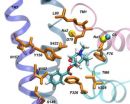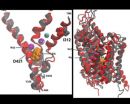(Press-News.org) Recent published research in the Journal of Clinical Investigation demonstrates how changes in dopamine signaling and dopamine transporter function are linked to neurological and psychiatric diseases, including early-onset Parkinsonism and attention deficit hyperactivity disorder (ADHD).
"The present findings should provide a critical basis for further exploration of how dopamine dysfunction and altered dopamine transporter function contribute to brain disorders" said Michelle Sahai, a postdoctoral associate at the Weill Cornell Medical College of Cornell University, adding "it also contributes to research efforts developing new ways to help the millions of people suffering."
Sahai is also studying the effects of cocaine, a widely abused substance with psychostimulant effects that targets the dopamine transporter. She and her colleagues expect to release these specific findings within the next year.
Losing Control
Dopamine is a neurotransmitter that plays an important role in our cognitive, emotional, and behavioral functioning. When activated from outside stimuli, nerve cells in the brain release dopamine, causing a chain reaction that releases even more of this chemical messenger.
To ensure that this doesn't result in an infinite loop of dopamine production, a protein called the dopamine transporter reabsorbs the dopamine back into the cell to terminate the process. As dopamine binds to its transporter, it is returned to the nerve cells for future use.
However, cocaine and other drugs like amphetamine, completely hijack this well-balanced system.
"When cocaine enters the bloodstream, it does not allow dopamine to bind to its transporter, which results in a rapid increase in dopamine levels," Sahai explained.
The competitive binding and subsequent excess dopamine is what causes euphoria, increased energy, and alertness. It also contributes to drug abuse and addiction.
To further understand the effects of drug abuse, Sahai and other researchers in the Harel Weinstein Lab at Cornell are delving into drug interactions on a molecular level.
Using supercomputer resources, she is able to observe the binding of dopamine and various drugs to a 3D model of the dopamine transporter on a molecular level. According to Sahai, the work requires very long simulations in terms of microseconds and seconds to understand how drugs interact with the transporters.
Through the Extreme Science and Engineering Discovery Environment (XSEDE), a virtual cyberinfrastructure that provides researchers access to computing resources, Sahai performs these simulations on Stampede, the world's 7th fastest supercomputer, at the Texas Advanced Computing Center (TACC).
"XSEDE-allocated resources are fundamental to helping us understand of how drugs work. There's no way we could perform these simulations on the machines we have in house. Through TACC as an XSEDE service provider, we can also expect an exponential increase in computational results, and good customer service and feedback."
Ultimately, Sahai's research will contribute to an existing body of work that is attempting to develop a cocaine binding inhibitor without suppressing the dopamine transporter.
"If we can understand how drugs bind to the dopamine transporter, then we can better understand drug abuse and add information on what's really important in designing therapeutic strategies to combat addiction," Sahai said.
A Common Link in the Research
While Sahai is still working to understand drug abuse, her simulations of the dopamine transporter have contributed to published research on Parkinson's disease and other neurological disorders.
In a collaborative study with the University of Copenhagen, Copenhagen University Hospital, and other research groups in the U.S. and Europe, researchers revealed the first known link between de novo mutations in the dopamine transporter and Parkinsonism in adults.
The study found that mutations can produce typical effects including debilitating tremors, major loss of motor control, and depression. The study also provides additional support for the idea that dopamine transporter mutations are a risk factor for attention deficit hyperactivity disorder (ADHD).
After identifying the dopamine transporter as the mutated gene linked to Parkinson's, researchers once again turned to the Harel Weinstein Lab due to its long-standing interest and investment in studying the human dopamine transporter.
Sahai's simulations using XSEDE and TACC's Stampede supercomputer supported clinical trials by offering greater insight into how the dopamine transporter is involved in neurological disorders.
"This research is very important to me," Sahai said. "I was able to look at the structure of the dopamine transporter on behalf of experimentalists and understand how irregularities in this protein are harming an actual person, instead of just looking at something isolated on a computer screen."
While there is currently no cure for Parkinson's disease, a deeper understanding of the specific mechanisms behind it will help the seven to ten million people afflicted with the disease.
"Like my work on drug abuse, the end goal is thinking about how we can help people. And it all comes back to drug design," Sahai said.
INFORMATION: END
The dopamine transporter
Researchers use TACC's Stampede supercomputer to study a common link between addiction and neurological disease
2014-07-22
ELSE PRESS RELEASES FROM THIS DATE:
Alaska frogs reach record lows in extreme temperature survival
2014-07-22
Freezing and thawing might not be good for the average steak, but it seems to help wood frogs each fall as they prepare to survive Alaska's winter cold.
"Alaska wood frogs spend more time freezing and thawing outside than a steak does in your freezer and the frog comes back to life in the spring in better shape than the steak," said Don Larson, University of Alaska Fairbanks graduate student and lead author on a recent paper demonstrating that freeze tolerance in Alaska wood frogs is more extreme than previously thought.
Although wood frogs are well-studied freeze-tolerant ...
Study examines presence of uterine cancers at the time of hysterectomy using morcellation
2014-07-22
Among women undergoing a minimally invasive hysterectomy using electric power morcellation, uterine cancers were present in 27 per 10,000 women at the time of the procedure, according to a study published by JAMA. There has been concern that this procedure, in which the uterus is fragmented into smaller pieces, may result in the spread of undetected malignancies.
Despite the commercial availability of electric power morcellators for 2 decades, accurate estimates of the prevalence of malignancy at the time of electric power morcellation (in this study referred to as morcellation) ...
The 92 percent clean plate club
2014-07-22
If you're a member of the Clean Plate Club – you eat pretty much everything you put on your plate – you're not alone! A new Cornell University study shows that the average adult eats 92% of whatever he or she puts on his or her plate. "If you put it on your plate, it's going into your stomach," says Brian Wansink Ph.D., author of the forthcoming book, Slim by Design, Professor of Marketing and Director of the Cornell Food and Brand Lab.
Wansink and co-author Katherine Abowd Johnson analyzed 1179 diners and concluded that we're a Clean Plate Planet. Although diners ...
Essays in English yield information about other languages
2014-07-22
Computer scientists at MIT and Israel's Technion have discovered an unexpected source of information about the world's languages: the habits of native speakers of those languages when writing in English.
The work could enable computers chewing through relatively accessible documents to approximate data that might take trained linguists months in the field to collect. But that data could in turn lead to better computational tools.
"These [linguistic] features that our system is learning are of course, on one hand, of nice theoretical interest for linguists," says Boris ...
NASA's Fermi finds a 'Transformer' pulsar
2014-07-22
VIDEO:
Zoom into an artist's rendering of AY Sextantis, a binary star system whose pulsar switched from radio emissions to high-energy gamma rays in 2013. This transition likely means the pulsar's...
Click here for more information.
In late June 2013, an exceptional binary containing a rapidly spinning neutron star underwent a dramatic change in behavior never before observed. The pulsar's radio beacon vanished, while at the same time the system brightened fivefold in gamma rays, ...
Forty-five percent rise in diagnostic imaging tests by GPs -- new study
2014-07-22
A 45 per cent rise in diagnostic imaging tests ordered by Australian GPs is being driven by increasing GP visits, a rising number of problems managed at consultations and a higher likelihood that GPs order imaging tests for these problems, according to a new University of Sydney study released today.
Based on a long term national survey of 9,802 GPs between 2002 and 2012, the report draws on data from more than 980,000 GP-patient encounter records to assess the extent to which GP's order tests in line with diagnostic imaging guidelines.
"Most imaging tests ordered by ...
Gene variant identified as a heart disease risk factor for women
2014-07-22
When it comes to heart disease, Dr. Ross Feldman says women are often in the dark. Historically, it was thought that heart disease was a men's-only disease, however, data has shown that post-menopausal women are just as likely as men to get heart disease and are less likely to be adequately diagnosed and treated. New research from Western University published online this week in the British Journal of Clinical Pharmacology brings to light a genetic basis for heart disease in women and helps to identify which women are more prone to heart disease.
The study, led by Dr. ...
Researchers create vaccine for dust-mite allergies
2014-07-22
If you're allergic to dust mites (and chances are you are), help may be on the way.
Researchers at the University of Iowa have developed a vaccine that can combat dust-mite allergies by naturally switching the body's immune response. In animal tests, the nano-sized vaccine package lowered lung inflammation by 83 percent despite repeated exposure to the allergens, according to the paper, published in the AAPS (American Association of Pharmaceutical Scientists) Journal. One big reason why it works, the researchers contend, is because the vaccine package contains a booster ...
Activity level may predict orthopedic outcomes
2014-07-22
According to a literature review in the July issue of the Journal of the American Academy of Orthopaedic Surgeons (JAAOS), patients' activity level is a strong predictor for how well they will do with certain treatments and how well they recover from injuries after treatment. Patients are encouraged to ask their orthopaedic surgeon if activity level is an important factor in their treatment decision. For example, more active patients are at a higher risk of re-injury after an anterior cruciate ligament (ACL) reconstruction, and activity level should be considered when deciding ...
UI study finds potential genetic link between epilepsy and neurodegenerative disorders
2014-07-22
A recent scientific discovery showed that mutations in prickle genes cause epilepsy, which in humans is a brain disorder characterized by repeated seizures over time. However, the mechanism responsible for generating prickle-associated seizures was unknown.
A new University of Iowa study, published online July 14 in the Proceedings of the National Academy of Sciences, reveals a novel pathway in the pathophysiology of epilepsy. UI researchers have identified the basic cellular mechanism that goes awry in prickle mutant flies, leading to the epilepsy-like seizures.
"This ...
LAST 30 PRESS RELEASES:
Scientists discover a new signaling pathway and design a novel drug for liver fibrosis
High-precision blood glucose level prediction achieved by few-molecule reservoir computing
The importance of communicating to the public during a pandemic, and the personal risk it can lead to
Improving health communication to save lives during epidemics
Antimicrobial-resistant hospital infections remain at least 12% above pre-pandemic levels, major US study finds
German study finds antibiotic use in patients hospitalised with COVID-19 appears to have no beneficial effect on clinical outcomes
Targeting specific protein regions offers a new treatment approach in medulloblastoma
$2.7 million grant to explore hypoxia’s impact on blood stem cells
Cardiovascular societies propel plans forward for a new American Board of Cardiovascular Medicine
Hebrew SeniorLife selected for nationwide collaborative to accelerate system-wide spread of age-friendly care for older adults
New tool helps identify babies at high-risk for RSV
Reno/Sparks selected to be part of Urban Heat Mapping Campaign
Advance in the treatment of acute heart failure identified
AGS honors Dr. Rainier P. Soriano with Dennis W. Jahnigen Memorial Award at #AGS24 for proven excellence in geriatrics education
New offshore wind turbines can take away energy from existing ones
Unprecedented research probes the relationship between sleep and memory in napping babies and young children
Job losses help explain increase in drug deaths among Black Americans
Nationwide, 32 local schools win NFL PLAY 60 grants for physical activity
Exposure to noise – even while in the egg – impairs bird development and fitness
Vitamin D availability enhances antitumor microbes in mice
Conservation actions have improved the state of biodiversity worldwide
Corporate emission targets are incompatible with global climate goals
Vitamin D alters mouse gut bacteria to give better cancer immunity
Escape the vapes: scientists call for global shift to curb consumer use of disposable technologies
First-of-its-kind study definitively shows that conservation actions are effective at halting and reversing biodiversity loss
A shortcut for drug discovery
Food in sight? The liver is ready!
Climate change could become the main driver of biodiversity decline by mid-century
Voluntary corporate emissions targets not enough to create real climate action
Curiosity promotes biodiversity
[Press-News.org] The dopamine transporterResearchers use TACC's Stampede supercomputer to study a common link between addiction and neurological disease






